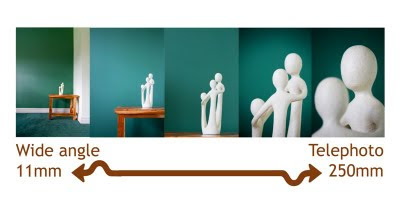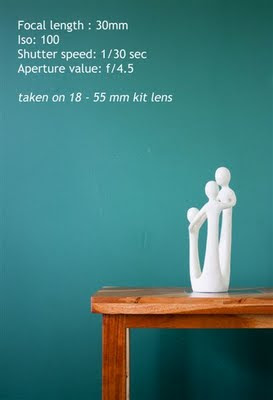
One of the ironies of my enjoying photography is my genetic inability to wink!! Normally my left hand steadies the camera while my left fore-finger covers my left eye. So this particular exercise to keep both eyes open was quite refreshing. To help with the exercise I set up a tripod, so the distance from the subject remained the same with all focal lengths and lenses.With both eyes open I moved my camera on tripod to the point that the viewfinder image through my prime lens (50mm) and the subject was the same. All subsequent images were taken from the same spot.


It is also noticeable how the different lenses capture the green differently in the above two shots. There was also quite alot of distortion using the wide-angle lens which, with straight walls is really accentuated. I am fond of the wide-angle lens, but for this type of subject it doesn't do the subject justice.
Both these images are taken with the same telephoto lens. For this type of subject I think this lens works really well. I like the short depth of field and you can pick up the texture clearly, particularly on the 250mm focal length. My only observation is the lens does create a heavy vignetting. This sometimes can work effectively, but on this occasion I didn't want it.
The second part of the exercise was to print all five images off and stand where the image and subject were equitable in size. For the standard focal length image, this was straightforward as it was not dissimilar to where I took the photo in the first place. I had to stand just under 2 metres away. In terms of a 'comfortable viewing distance', I guess this was. I wasn't 'on-top' of the subject and not so far away it was small and difficult to see. For the two wide-angle images, particularly with the focal length of 11mm, I had to walk away from the subject some distance; stepping back, then on to the bed (still too close) and over the other side of the bed until the distance between me and the subject was, I guess, around 4m.
Clearly, the reverse was the case when I took the images taken with the telephoto lens. I returned to where I started and then forward until I was crouching right next to the subject - definitely not a 'comfortable viewing distance'. If the subject was a person, I would definitely be invading their 'personal space'.
The shot that works best for me is the 250mm telephoto shot because you can pick up the texture in the head, followed by the image taken at the standard focal length which compositionally is stronger than the others. The wide-angle shots had no impact at all. In conclusion, by carrying out this exercise the choice of lens and therefore focal length can dramatically alter the impact and personality of the image you are taking. It also demonstrates to me that I must continue to alter and change the lenses I use rather than sticking to my favourites: the wide-angle tokina lens for landscapes and 50mm prime for portraits.
The shot that works best for me is the 250mm telephoto shot because you can pick up the texture in the head, followed by the image taken at the standard focal length which compositionally is stronger than the others. The wide-angle shots had no impact at all. In conclusion, by carrying out this exercise the choice of lens and therefore focal length can dramatically alter the impact and personality of the image you are taking. It also demonstrates to me that I must continue to alter and change the lenses I use rather than sticking to my favourites: the wide-angle tokina lens for landscapes and 50mm prime for portraits.




No comments:
Post a Comment